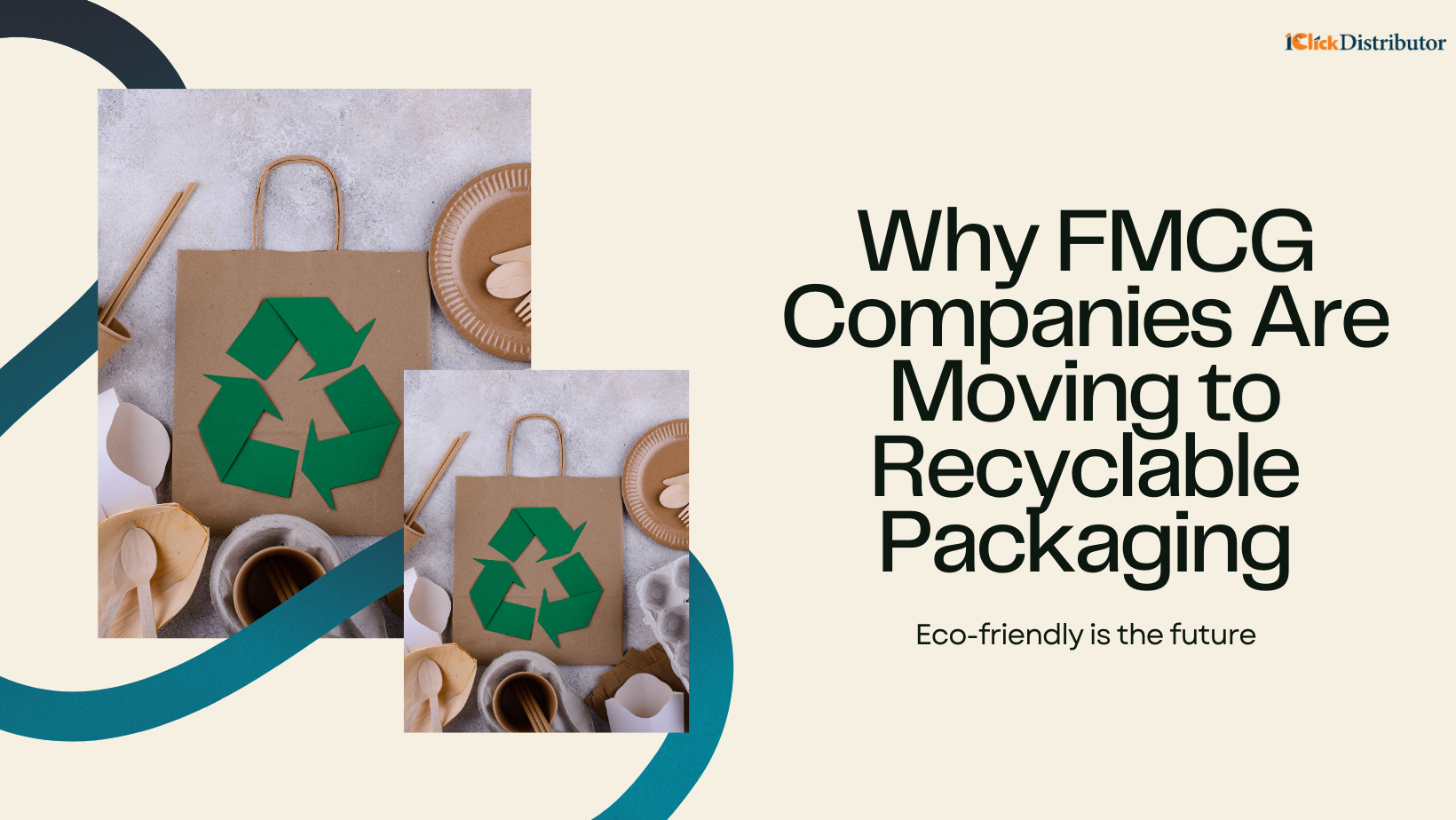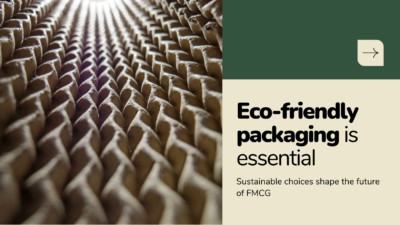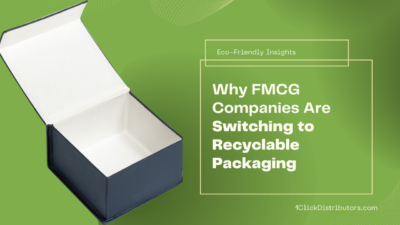Why FMCG Companies Are Moving to Recyclable Packaging : Over the past few years, the Fast-Moving Consumer Goods (FMCG) industry around the world has witnessed a major shift towards recyclable packaging. It is not a trend but a strategic response to changing consumer preferences, environmental issues, and regulatory demands. We examine the reasons for this shift, its benefits, and some real-world examples below.
Rising Demand for Sustainable Practices
Sustainability has become a necessity rather than a choice. Consumers are now more aware of the environmental footprint of their purchases than ever before. According to a Nielsen report, 73% of global consumers are willing to change their consumption habits to reduce their environmental impact. This has led FMCG companies to reassess their packaging strategies.
Recyclable packaging addresses several key challenges:
– Reduced landfill waste.
– Reduced carbon emissions during production and disposal.
– Securing the world economy transition into circularity.
Regulatory Compliance and Industry Standards
The world governments and regulatory authorities are upping their environmental regulations. For instance:
– The European Union’s Circular Economy Action Plan calls for all consumer goods to have 100% recyclable packaging by the year 2030.
– The Plastic Waste Management Rules, 2022, made it mandatory for FMCG companies in India to adopt EPR for plastic waste.
These regulations compel FMCG companies to embrace recyclable packaging so as not to incur fines and ensure smooth operation of their business.
It is essential to the compliance and competitiveness of the business.
Cost-Efficiency in the Long Run
The apparent cost of the initial changeover to recyclable packaging is an investment that, over time, pays off handsomely. The use of sustainable materials and decreased reliance on virgin resources decrease production costs for FMCG companies. For example, Unilever saved more than €200.
Coca-Cola’s “World Without Waste” is an initiative set to collect and recycle one bottle or can for each product sold by 2030. This means Coca-Cola would close the loop that helps in saving material costs. Moreover, use of recyclable packaging reduces reliance on fossil fuel, which continues to fluctuate in price owing to geopolitical dynamics across the globe.
Consumer Loyalty and Brand Reputation
It makes a brand stick to the conscience of eco-aware consumers. An IBM survey suggests that 77% of its customers believe that sustainability is something to be kept in mind when it comes to a purchase, while 57% are willing to pay more for sustainable products.
When FMCG brands opt for recyclable packaging, they enhance brand reputation and get loyal customers on board. It can be understood by an example of:
Procter & Gamble (P&G), which introduced fully recyclable shampoo bottles made of beach plastic in its Head & Shoulders line. It improved their environmental image and allowed them to also grab new market share.
Technological Developments Facilitating the Evolution
Recent technical developments have enabled FMCG companies to adopt recyclable materials without compromising on product quality or shelf life. The important inventions include:
Biodegradable plastics that naturally degrade within months.
Paper-based packaging with moisture-resistant coatings to replace single-use plastics.
Mono-material packaging that simplifies the recycling process.
For example, Nestlé has developed a paper-based wrapper for KitKat, demonstrating that mass production can be done in a way that incorporates recyclable solutions.
Real-World Examples of FMCG Companies Leading the Change
- Unilever’s Commitment to Recyclability
Unilever has set a challenging target to ensure that 100% of its plastic packaging is fully reusable, recyclable, or compostable by 2025. The company has rolled out recyclable sachets for its detergent brands, significantly cutting down on plastic waste.
Commitment to Sustainability by Unilever
Unilever, a market leader in the FMCG industry, has been very successful in adopting recyclable packaging. In 2017, the company promised to make 100% of its plastic packaging fully reusable, recyclable, or compostable by 2025. So far, as of the end of 2020, Unilever had achieved 50%.
Why FMCG Companies Are Moving to Recyclable Packaging
Unilever’s commitment is an exemplary demonstration of the actual achievements possible in sustainability with focused initiatives. This becomes a benchmark for other players to emulate.
Nestlé’s Sustainable Packaging Revolution
Another FMCG leader, Nestle, has made ambitious commitments in the area of recyclable packaging. In 2018, Nestle made a commitment that all its packaging should be recyclable or reusable by 2025. Since making that commitment, Nestle introduced some innovative solutions, such as paper-based packaging for its popular brand Smarties, and recyclable plastic wrappers for its confectionery.
Why FMCG Companies Are Switching to Recyclable Packaging: Nestlé’s strategy is an excellent example of the viability of making changes in the scale of packaging. The company has been focusing on sustainability, which has positively influenced consumers and other stakeholders.
Why FMCG Companies Are Switching to Recyclable Packaging: One of the primary reasons is the reduction in environmental impact through waste from packaging. FMCG companies are taking ownership of reducing pollution and minimizing carbon footprint
Regulatory Push: Governments and Policies
Across the world, governments are imposing strict regulations to ensure the reduction of plastic waste and promotion of recycling. For example, the European Union’s Single-Use Plastics Directive works to address plastic pollution through banning some single-use plastic products and having a higher recycling rate.
Why FMCG Companies are Moving Towards Recyclable Packaging: One of the strongest driving factors for FMCG companies is to adopt recyclable packaging. This is in order to follow the regulatory compliance, as well as to avoid fines and remain efficient in the operations.
Issues in Implementing Recyclable Packaging
While the benefits of recyclable packaging are self-evident, the journey is not easy:
High lead times: A transition into recyclable materials requires significant investment in new equipment and a change in supply chain.
Limited supply of eco-friendly material: Since the demand is high, competition for this raw material has intensified.
Consumer education: It is essential that the consumer understands how importance recycling is and where to dispose of packaging.
To address these issues, FMCG companies are collaborating with governments, NGOs, and private organizations to create scalable solutions.
Role of Circular Economy in FMCG Packaging
The circular economy is based on the principle of reusing materials to create a closed-loop system. For FMCG companies, this means designing packaging that:
Is recyclable.
Can be reintegrated into the supply chain after use.
Reduces dependence on virgin materials.
Leading the way are brands such as Mars and Mondelez, which are transforming packaging designs to increase recyclability while maintaining aesthetics and functionality.
Future Outlook: A Greener FMCG Landscape
This change toward recyclable packaging is more than just a passing trend for the FMCG industry. In this way, such companies do not only support the conservation of the environment but are also one step ahead of others in this competition game. It does this through innovation in the development of materials, forming partnership and consumer education on FMCG, creating an opening into a bright, sustainable future as well as high profitability.
The real question now is no longer why FMCG companies should shift to recyclable packaging but how fast they can make it happen because the demand for sustainability is growing.Why FMCG Companies Are Moving to Recyclable Packaging
Over the past few years, the Fast-Moving Consumer Goods (FMCG) industry around the world has witnessed a major shift towards recyclable packaging. It is not a trend but a strategic response to changing consumer preferences, environmental issues, and regulatory demands. We examine the reasons for this shift, its benefits, and some real-world examples below.
Rising Demand for Sustainable Practices
Sustainability has become a necessity rather than a choice. Consumers are now more aware of the environmental footprint of their purchases than ever before. According to a Nielsen report, 73% of global consumers are willing to change their consumption habits to reduce their environmental impact. This has led FMCG companies to reassess their packaging strategies.
Recyclable packaging addresses several key challenges:
– Reduced landfill waste.
– Reduced carbon emissions during production and disposal.
– Securing the world economy transition into circularity.
Regulatory Compliance and Industry Standards
The world governments and regulatory authorities are upping their environmental regulations. For instance:
– The European Union’s Circular Economy Action Plan calls for all consumer goods to have 100% recyclable packaging by the year 2030.
– The Plastic Waste Management Rules, 2022, made it mandatory for FMCG companies in India to adopt EPR for plastic waste.
These regulations compel FMCG companies to embrace recyclable packaging so as not to incur fines and ensure smooth operation of their business.
It is essential to the compliance and competitiveness of the business.
Cost-Efficiency in the Long Run
The apparent cost of the initial changeover to recyclable packaging is an investment that, over time, pays off handsomely. The use of sustainable materials and decreased reliance on virgin resources decrease production costs for FMCG companies. For example, Unilever saved more than €200.
Coca-Cola’s “World Without Waste” is an initiative set to collect and recycle one bottle or can for each product sold by 2030. This means Coca-Cola would close the loop that helps in saving material costs. Moreover, use of recyclable packaging reduces reliance on fossil fuel, which continues to fluctuate in price owing to geopolitical dynamics across the globe.
Consumer Loyalty and Brand Reputation
It makes a brand stick to the conscience of eco-aware consumers. An IBM survey suggests that 77% of its customers believe that sustainability is something to be kept in mind when it comes to a purchase, while 57% are willing to pay more for sustainable products.
When FMCG brands opt for recyclable packaging, they enhance brand reputation and get loyal customers on board. It can be understood by an example of:
Procter & Gamble (P&G), which introduced fully recyclable shampoo bottles made of beach plastic in its Head & Shoulders line. It improved their environmental image and allowed them to also grab new market share.
Technological Developments Facilitating the Evolution
Recent technical developments have enabled FMCG companies to adopt recyclable materials without compromising on product quality or shelf life. The important inventions include:
Biodegradable plastics that naturally degrade within months.
Paper-based packaging with moisture-resistant coatings to replace single-use plastics.
Mono-material packaging that simplifies the recycling process.
For example, Nestlé has developed a paper-based wrapper for KitKat, demonstrating that mass production can be done in a way that incorporates recyclable solutions.
Real-World Examples of FMCG Companies Leading the Change
Unilever’s Commitment to Recyclability
Unilever has set a challenging target to ensure that 100% of its plastic packaging is fully reusable, recyclable, or compostable by 2025. The company has rolled out recyclable sachets for its detergent brands, significantly cutting down on plastic waste.
Commitment to Sustainability by Unilever
Unilever, a market leader in the FMCG industry, has been very successful in adopting recyclable packaging. In 2017, the company promised to make 100% of its plastic packaging fully reusable, recyclable, or compostable by 2025. So far, as of the end of 2020, Unilever had achieved 50%.
Why FMCG Companies Are Switching to Recyclable Packaging: Unilever’s commitment is an exemplary demonstration of the actual achievements possible in sustainability with focused initiatives. This becomes a benchmark for other players to emulate.
Nestlé’s Sustainable Packaging Revolution
Another FMCG leader, Nestle, has made ambitious commitments in the area of recyclable packaging. In 2018, Nestle made a commitment that all its packaging should be recyclable or reusable by 2025. Since making that commitment, Nestle introduced some innovative solutions, such as paper-based packaging for its popular brand Smarties, and recyclable plastic wrappers for its confectionery.
Why FMCG Companies Are Switching to Recyclable Packaging: Nestlé’s strategy is an excellent example of the viability of making changes in the scale of packaging. The company has been focusing on sustainability, which has positively influenced consumers and other stakeholders.
Why FMCG Companies Are Moving to Recyclable Packaging: One of the primary reasons is the reduction in environmental impact through waste from packaging. FMCG companies are taking ownership of reducing pollution and minimizing carbon footprint
Regulatory Push: Governments and Policies
Across the world, governments are imposing strict regulations to ensure the reduction of plastic waste and promotion of recycling. For example, the European Union’s Single-Use Plastics Directive works to address plastic pollution through banning some single-use plastic products and having a higher recycling rate.
Why FMCG Companies are Moving Towards Recyclable Packaging: One of the strongest driving factors for FMCG companies is to adopt recyclable packaging. This is in order to follow the regulatory compliance, as well as to avoid fines and remain efficient in the operations.
Issues in Implementing Recyclable Packaging
While the benefits of recyclable packaging are self-evident, the journey is not easy:
High lead times: A transition into recyclable materials requires significant investment in new equipment and a change in supply chain.
Limited supply of eco-friendly material: Since the demand is high, competition for this raw material has intensified.
Consumer education: It is essential that the consumer understands how importance recycling is and where to dispose of packaging.
To address these issues, FMCG companies are collaborating with governments, NGOs, and private organizations to create scalable solutions.
Role of Circular Economy in FMCG Packaging
The circular economy is based on the principle of reusing materials to create a closed-loop system. For FMCG companies, this means designing packaging that:
Is recyclable.
Can be reintegrated into the supply chain after use.
Reduces dependence on virgin materials.
Leading the way are brands such as Mars and Mondelez, which are transforming packaging designs to increase recyclability while maintaining aesthetics and functionality.
Future Outlook: A Greener FMCG Landscape
This change toward recyclable packaging is more than just a passing trend for the FMCG industry. In this way, such companies do not only support the conservation of the environment but are also one step ahead of others in this competition game. It does this through innovation in the development of materials, forming partnership and consumer education on FMCG, creating an opening into a bright, sustainable future as well as high profitability.
The real question now is no longer why FMCG companies should shift to recyclable packaging but how fast they can make it happen because the demand for sustainability is growing.



